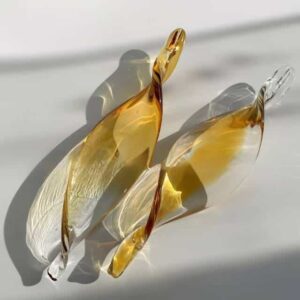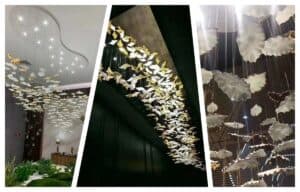The History and Art of Murano Chandelier Glass
Published on 2023年 9月 16日 by iartglass
Product Categories Information
| Product Category | Description |
|---|---|
| Blown Glass | Hand-crafted, intricate glass pieces |
| Murano Chandelier Parts | Specialized components for Murano chandeliers |
| Glass Shade | Elegant shades for various light fixtures |
| Glass Table Lamp Base | Bases that add aesthetic flair to table lamps |
| Pressed Glass | Durable, uniquely designed glass pieces |
Introduction

Ah, Murano chandelier glass—words that conjure an opulent dance of light and art! This stunning form of craftsmanship originated in the romantic canals of Italy but has left its shimmering mark globally. Why the fuss? Well, the history and artistry of Murano glass are as captivating as the glow they emit.
Origins of Murano Glass

Let’s rewind the clock to the 7th century in Venice, Italy. Imagine a thriving city on water, bursting with creativity. Venice was the birthplace of what we now passionately refer to as Murano Glass. But why the name ‘Murano’?
In 1291, all glassmakers were shuffled off to the island of Murano. It wasn’t a random choice; it was a fire safety measure. Glassmaking involves open flames, and Venice was a city with a whole lot of wooden structures. Besides, keeping the talent on an island made it easier to protect trade secrets!
Why Murano Island?
- Fire Safety: Open flames and a wooden city don’t mix.
- Trade Secrets: Easier to keep skills confined to an island.
- Quality Control: Maintaining standards was more straightforward.
So, there you have it—two snapshots into the spellbinding world of Murano glass. Ready to dive deeper? Stay tuned!
Related Reading: From Molten to Marvelous: The Mesmerizing Journey of Custom Hand-Blown Glass
Stay tuned for more dazzling stories from the world of hand-blown glass artistry!
Evolution of Murano Glass

From ancient bellows to modern kilns, the art of Murano glassmaking has come a long way. But one thing hasn’t changed: an uncompromising focus on quality, beauty, and a magician’s attention to detail. Let’s fast-forward from the 7th century to today. How did Murano glass make the jump from simple goblets to awe-inspiring Blown Glass chandeliers?
Time Travel in Glass Evolution
| Century | Key Innovations |
|---|---|
| 14th | Introduction of crystalline glass |
| 15th | Development of enameled glass (smalto) |
| 16th | Invention of imitation gemstones |
| 17th | Spread to other European countries |
| 18th | Decline and subsequent revival |
| 19th | Advent of artistic glass studios |
| 20th | Modern techniques and global recognition |
This evolution wasn’t accidental. It was shaped by a relentless pursuit of mastery, cutting-edge technology, and, of course, a dash of Italian flair.
Related Reading: Glass Unveiled: The Fascinating Journey from Science to Stunning Artistry
Famous Murano Glass Artisans

The credits for this eye-popping art form go to the artisans who’ve shaped it—literally. Artists like Angelo Barovier and Lino Tagliapietra have brought the craft to global fame. But let’s not forget the anonymous masters of yore; their unrecorded innovation laid the groundwork for today’s marvels.
Stalwarts of Murano Glass
- Angelo Barovier: Credited with creating crystalline glass.
- Lino Tagliapietra: A modern-day legend who fuses tradition and innovation.
- Archimede Seguso: Known for traditional techniques like ‘a lume’.
- Carlo Scarpa: Combined glass with other materials like bronze.
- Pino Signoretto: Famous for his detailed figurines.
Each artisan brings a unique style, technique, and vision to the table, or rather, to the furnace! Murano glass is a collaborative tapestry of individual genius.
Related Reading: The Enchanting Alchemy of Glassblowing: A Deep Dive Into Its Art and Science
There you go—another chapter in the ongoing saga of Murano glass. What’s next? Hold on to your hats; we’re not done yet!
The Craftsmanship of Murano Chandeliers

When it comes to Murano chandeliers, it’s all about finesse. But it’s not just about the final product—it’s the hours of labor, the sweat, and the delicate dance of molten glass shaping into something extraordinary. Picture this: An artisan stands in front of a furnace, glowing like the sun, and yet, with precise moves, creates complex Murano Chandelier Parts for a work of art.
The Magic Behind the Making
- Step 1: Collect the materials. This isn’t just any glass; it’s a special blend to achieve optimum purity and color.
- Step 2: Into the furnace! Glass chunks melt at 1700°C.
- Step 3: Shaping begins. Molten glass is gathered on a rod, cooled, and then reheated to perfection.
- Step 4: The artisan breathes life—literally—into the glass. Hand blowing is an art form in itself.
- Step 5: Cutting, polishing, and assembling. The final steps that bring a Murano chandelier together.
Related Reading: From Molten Magic to Mesmerizing Art: The Journey of Hand Blown Glass
Characteristics of Murano Chandelier Glass

So what sets a Murano chandelier apart from, let’s say, a regular old department
store find? Three words: color, design, intricacy.
Character Trait Breakdown
| Characteristic | Why It Matters |
|---|---|
| Color | Vivid hues, often mixed for a rainbow effect |
| Design | Intricate patterns, unique to each piece |
| Intricacy | Minute detailing, making each part a mini-artwork |
Related Reading: Handblown Glass Artistry: Navigating the Nuances of Modern and Classic Designs
Continuation of Tradition

It’s not just an art form; it’s a legacy. Many of the artisans at the furnace today are descendants of the glass maestros of yesteryears. They’ve inherited not just the family name but also the family skill, and boy, are they taking it to the next level! Murano isn’t about resting on past glories; it’s about shaping the molten future of Glass Table Lamp Base and chandeliers.
Torchbearers of Tradition
- Roberto Dona: An expert in various techniques, ensuring Murano’s legacy stays versatile.
- Laura de Santillana: A descendant of the iconic Barovier family, she brings a modern twist to traditional forms.
- Marino Moretti: He maintains traditional colors and designs while exploring contemporary art.
Tradition isn’t static; it flows like molten glass through the hands of these modern artisans.
Related Reading: Product: Handmade Murano Glass Jellyfish-Shaped Pendant
Excited? Wait until you see where you can find these masterpieces and how they’re appreciated worldwide. Stay tuned!
Where to Find Murano Chandelier Glass

Hunting for that perfect Murano chandelier to crown your living room? Look no further. Whether you’re a browser in boutiques or a netizen navigating the online jungle, there’s a Murano for you.
Physical Stores vs. Online Shops
| Store Type | Pros | Cons |
|---|---|---|
| Physical | Touch, feel, immediate buy | Limited options, travel |
| Online | Variety, direct-from-source | Can’t ‘feel’ the product |
Must-Visit Spots: Venice, Italy (where else?), New York City galleries, and of course, our very own offerings.
Related Reading: The Enchanting Alchemy of Glassblowing: A Deep Dive Into Its Art and Science
Appreciating Murano Glass

Murano isn’t just glass; it’s a language spoken through color, shape, and light. Globally, it has a cult-like following. From Hollywood celebrities to the British royal family, everyone wants a piece of Murano.
Noteworthy Anecdotes
- The Millefiori Technique: This style has been mimicked worldwide but never duplicated.
- Murano in The Vatican: Yes, the Pope owns a Murano chandelier. Talk about divine taste!
- Murano at the Oscars: Best Supporting Decor? If there was a category, Murano would be the perennial winner.
Related Reading: From Molten to Marvelous: The Mesmerizing Journey of Custom Hand-Blown Glass
Conclusion

Murano chandelier glass isn’t a mere product; it’s a piece of history, a slice of art, and a dash of luxury, all blended into one radiant masterpiece. From the Venetian lagoons of the 7th century to modern-day homes, Murano remains the jewel of Blown Glass artistry. Its legacy isn’t just alive; it’s thriving, evolving, and capturing imaginations worldwide. So next time you see a Murano chandelier, remember—you’re not just looking at glass; you’re witnessing a timeless tale of art and passion.
Related Reading: Glass Unveiled: The Fascinating Journey From Science to Stunning Artistry
Explore Further: Product: Handmade Murano Glass Airplane Shape Charm
That’s it for this glowing adventure. Stay illuminated!
Frequently Asked Questions (FAQ)
What is the history of the Murano chandelier?
The history of the Murano chandelier dates back to the 7th century in Venice, Italy. It’s a legacy of refined artisanship and intricate design.
How can you tell a Murano chandelier?
A genuine Murano chandelier will often come with a certificate of authenticity. Also, the unparalleled quality of the glass and intricate designs are good indicators.
What is so special about Murano glass?
Murano glass is renowned for its color brilliance, intricate designs, and the exceptional skill required to produce it.
How can you tell if Murano glass is vintage?
Certain techniques and styles can help you identify vintage Murano glass. Certificates, signatures, and expert opinions are reliable ways to authenticate.
What does the chandelier symbolize?
The chandelier is often considered a symbol of luxury, elegance, and artistic flair, which is especially true for Murano chandeliers.
Is all Murano art glass signed?
Not necessarily. While many pieces are signed by the artist or have a certificate of authenticity, it’s not a rule for all Murano glass.
How do you clean a Murano glass chandelier?
Cleaning a Murano chandelier requires special care. Soft cloths, gentle cleansers, and avoiding abrasive materials will keep it sparkling.
What makes a chandelier valuable?
Factors like the quality of materials, craftsmanship, design complexity, and brand or artist reputation contribute to a chandelier’s value.
Who is the famous glass artist in Murano?
Artists like Lino Tagliapietra and Dale Chihuly have gained international acclaim for their work in Murano glass.
Related Reading: Handblown Glass Artistry: Navigating the Nuances of Modern and Classic Designs




